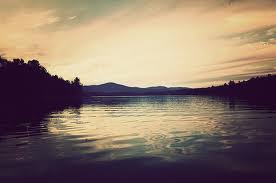More Woody Fungi Found Near Maine Lakefront Properties
Woody Fungi Identification Entices Maine Lakefront Property Owners
December 4, 2014Out and About for the Bangor Lakes Region of Maine Dec. 11-17
December 11, 2014More Woody Fungi Found Near Maine Lakefront Properties
Look for Woody Fungi among the Trees Surrounding Ebeemee Lake in the Bangor Lakes Region of Maine
by Leigh Macmillen Hayes
What’s fleshy, leathery and woody, and fruits profusely in the Lakes Regions of Maine? Woody fungi, of course.
Along the shores of our lakefronts and on the hikes we take in Maine, we often see these mushrooms growing on dead or decaying trees, logs and snags.
Though I don’t know enough to suggest that you use any of these for edible or medicinal purposes, I do like to find them on my tramps in the woods. In other words, DO NOT eat any mushroom unless you are absolutely certain of its identity: many mushroom species look alike and some species are highly poisonous.
As important organisms, fungi serve many vital functions in forest ecosystems from decomposition and nutrient cycling to symbiotic relationships with trees and other plants and as biological control of other fungi. The fruiting bodies or mushrooms, are sources of food for wildlife, and fungi that cause decay in living trees are beneficial to many species of birds and mammals.
The most commonly encountered fungi in our woodlands throughout the year are the wood-decaying bracket and conk fungi, aka polypores.
Take a look at the photographs and descriptions below. Some may be familiar to you.
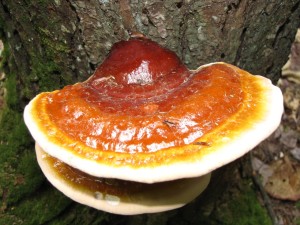
Red-belted Polypore (Fomitopsis pinicola) With its often varnished appearance, the Red-belted Polypore has concentric zones of red to dark brownish red. Toward the margin it is white or yellow. Though it prefers conifers, this bracket or shelf-like (sometimes it even looks like a horse’s hoof) fungi is also known to grow on hardwoods.
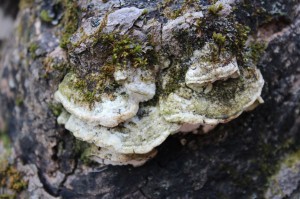
Mossy Maple Polypore (Oxyporous populinus) Much more particular about its tree of choice, Mossy Maple Polypore is often found growing out of wounds in maple trees. Though the cap and underside are pale white, it derives the other part of its name from the green moss that usually grows on top of it.
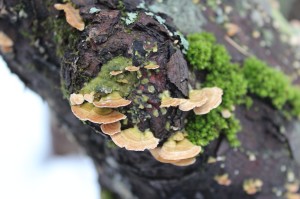
Velvet-toothed Polypore (Trichaptum sp.) So, I don’t know about you, but I’ve been tricked by this one for years. Every time I saw it, I was certain I was looking at Turkey Tail (Trametes versicolor). Not so. Much more common than Turkey Tail is the Velvet-toothed Polypore. Now I know to look at the underside for the jagged and tooth-like pores that are velvet when fresh, but turn brownish as they age.
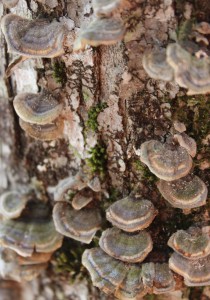
Turkey Tail (Trametes versicolor) As the name implies, these mushrooms are variously colored. Thin and flexible, this polypore grows in large clusters. Though it’s quite common, I’ve noticed lately that there are more Velvet-toothed Polypores in my neck of the woods. How to tell the difference? The underside of a Turkey Tails is whitish and the pores are quite small, whereas the Velvet-toothed Polypore features those jagged, tooth-like pores. Always look at the underside. So many clues are hidden there.
(photo credit: Leigh Macmillen Hayes)
To view lakefront property for sale on Ebeemee Lake in the Bangor Lakes Region of Maine, click on the green box above.
To learn more about Ebeemee Lake and the Bangor Lakes Region, check out the blog links below.
Ebeemee Lake, Ebeemee Township, Maine: Lakefront Property Access to Four Great Ponds
Lake Wassookeag, Dexter, Maine: Shining Water Beside Lakefront Real Estate

